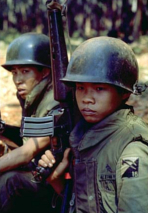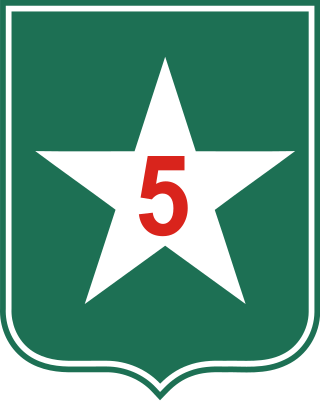
The Battle of Khe Sanh was conducted in the Khe Sanh area of northwestern Quảng Trị Province, Republic of Vietnam, during the Vietnam War. The main US forces defending Khe Sanh Combat Base (KSCB) were two regiments of the United States Marine Corps supported by elements from the United States Army and the United States Air Force (USAF), as well as a small number of Army of the Republic of Vietnam (ARVN) troops. These were pitted against two to three divisional-size elements of the North Vietnamese People's Army of Vietnam (PAVN).

The battle of Dak To in Vietnam was a series of major engagements of the Vietnam War that took place between 3 and 23 November 1967, in Kon Tum Province, in the Central Highlands of the Republic of Vietnam. The action at Đắk Tô was one of a series of People's Army of Vietnam (PAVN) offensive initiatives that began during the second half of the year. PAVN attacks at Lộc Ninh, Sông Bé and at Con Thien and Khe Sanh,, were other actions which, combined with Đắk Tô, became known as "the border battles". The post hoc purported objective of the PAVN forces was to distract American and South Vietnamese forces away from cities towards the borders in preparation for the Tet Offensive.

Ngô Quang Trưởng was an officer in the Army of the Republic of Vietnam (ARVN). Trưởng gained his commission in the Vietnamese National Army in 1954 and moved up the ranks over the next decade, mostly in the Airborne Brigade. In 1966, Trưởng commanded a division for the first time after he was given command of the 1st Division after helping to quell the Buddhist Uprising. He rebuilt the unit after this divisive period and used it to repel the communists and reclaimed the imperial citadel of Huế after weeks of bitter street fighting during the Tết Offensive. In 1970, Trưởng was given command of IV Corps in the Mekong Delta and improved the situation there to such an extent that he allowed some of his forces to be redeployed to other parts of the country that were finding the communist pressure difficult.

Operation Union II was a search and destroy mission in the Quế Sơn Valley carried out by the 5th Marine Regiment. Launched on 26 May 1967 the operation ended on 5 June. U.S. reported the People's Army of Vietnam (PAVN) lost 701 killed and 23 captured, while U.S. casualties were 110 killed and 241 wounded.

The Battle of Xuân Lộc was the last major battle of the Vietnam War that took place at Xuân Lộc, Đồng Nai Province. Over a period of twelve days between 9 and 21 April 1975, the outnumbered South Vietnamese reserves attempted to stop the North Vietnamese forces from overunning the town and breaking through towards South Vietnam's capital, Saigon. The Army of the Republic of Vietnam (ARVN) committed almost all their remaining mobile forces, especially the 18th Division, under Brigadier General Lê Minh Đảo, to the defence of the strategic crossroads town of Xuân Lộc, hoping to stall the People's Army of Vietnam (PAVN) advance. The battle ended when the town of Xuân Lộc was captured by the PAVN 4th Army Corps led by Major General Hoàng Cầm.

The 1975 spring offensive, officially known as the general offensive and uprising of spring 1975, was the final North Vietnamese campaign in the Vietnam War that led to the capitulation of Republic of Vietnam. After the initial success capturing Phước Long Province, the North Vietnamese leadership increased the scope of the People's Army of Vietnam's (PAVN) offensive and captured and held the key Central Highlands city of Buôn Ma Thuột between 10 and 18 March. These operations were intended to be preparatory to launching a general offensive in 1976.

Operation Lam Son 719 or 9th Route – Southern Laos Campaign was a limited-objective offensive campaign conducted in the southeastern portion of the Kingdom of Laos. The campaign was carried out by the armed forces of South Vietnam between 8 February and 25 March 1971, during the Vietnam War. The United States provided logistical, aerial and artillery support for the operation, but its ground forces were prohibited by law from entering Laotian territory. The objective of the campaign was the disruption of a possible future offensive by the People's Army of Vietnam (PAVN), whose logistical system within Laos was known as the Ho Chi Minh Trail.

The Battle of Huế, also called the siege of Huế, was a major military engagement in the Tết Offensive launched by North Vietnam and the Việt Cộng during the Vietnam War. After initially losing control of most of Huế and its surroundings, the combined South Vietnamese and American forces gradually recaptured the city over one month of intense fighting. The battle was one of the longest and bloodiest of the war, and the battle negatively affected American public perception of the war.

Lê Văn Hưng was an infantry general of the Army of the Republic of Vietnam.

The Battle of An Lộc was a major battle of the Vietnam War that lasted for 66 days and culminated in a tactical victory for South Vietnam. The struggle for An Lộc in 1972 was an important battle of the war, as South Vietnamese forces halted the North Vietnamese advance towards Saigon.

The Battle of Lộc Ninh was a major battle fought during the Easter Offensive during the Vietnam War, which took place in Bình Long Province, South Vietnam between 4 and 7 April 1972. Towards the end of 1971, North Vietnamese leaders decided to launch a major offensive against South Vietnam, with the objective of destroying Army of the Republic of Vietnam (ARVN) units and capturing as much territory as possible, in order to strengthen their bargaining position in the Paris Peace Accords. On 30 March 1972, two People's Army of Vietnam (PAVN) divisions smashed through the Vietnamese Demilitarized Zone, marking the commencement of the Easter Offensive. They quickly overwhelmed South Vietnamese units in the I Corps Tactical Zone. With the rapid collapse of South Vietnamese forces in the northern provinces of South Vietnam, PAVN and Viet Cong (VC) forces began preparing for their next offensive, targeting Bình Long Province in the rubber plantation region north of Saigon. On 4 April, the VC 5th Division opened their attack on Lộc Ninh, defended by the ARVN 9th Infantry Regiment. After three days of fighting, the vastly outnumbered ARVN forces, though well supported by American air power, were forced to abandon their positions in Lộc Ninh.

The First Battle of Quảng Trị resulted in the first major victory for the People's Army of Vietnam (PAVN) during the Easter Offensive of 1972. Quảng Trị Province was a major battleground for the opposing forces during the Vietnam War. As South Vietnamese soldiers were gradually replacing their American counterparts, North Vietnam's General Văn Tiến Dũng was preparing to engage three of his divisions in the province. Just months before the battle, the Army of the Republic of Vietnam (ARVN) deployed its newly formed 3rd Division to the areas along the Vietnamese Demilitarized Zone (DMZ) to take over former US bases. North Vietnamese forces deployed against the inexperienced ARVN 3rd Division included the PAVN 304th, 308th and 324B Divisions.

The 18th Division was an infantry division in the III Corps of the Army of the Republic of Vietnam (ARVN). The U.S. Military Assistance Command Vietnam considered the 18th as undisciplined and it was well known throughout the ARVN for its "cowboy" reputation. In 1975 the 18th was made famous for its tenacious defense of Xuân Lộc, the last major battle before the Fall of Saigon.

The Vietnamese Rangers (Vietnamese: Biệt Động Quân; Chữ Hán: 別動軍), commonly known as the ARVN Rangers or Vietnamese Ranger Corp (VNRC), were the light infantry of the Army of the Republic of Vietnam. Trained and assisted by American Special Forces and Ranger advisers, the Vietnamese Rangers infiltrated beyond enemy lines in search and destroy missions. Initially trained as a counter-insurgency light infantry force by removing the fourth company each of the existing infantry battalions, they later expanded into a swing force capable of conventional as well as counter-insurgency operations, and were relied on to retake captured regions. Later during Vietnamization the Civilian Irregular Defense Group program was transferred from MACV and integrated as Border Battalions responsible for manning remote outposts in the Central Highlands.

The First Battle of Loc Ninh was a battle during the Vietnam War that occurred between 29 October and 7 November 1967, fought by the Viet Cong, Army of the Republic of Vietnam (ARVN), Civilian Irregular Defense Group and the United States Army.
Operation Texas Star was a military operation of the Vietnam War that took place in Quảng Trị and Thừa Thiên Provinces from 1 April to 5 September 1970.

The Fifth Division of the Army of the Republic of Vietnam (ARVN)—the army of the nation state of South Vietnam that existed from 1955 to 1975—was part of the III Corps that oversaw the region of the country surrounding the capital, Saigon.

The 1st Division of the Army of the Republic of Vietnam (ARVN)—the army of the nation state of South Vietnam that existed from 1955 to 1975—was part of the I Corps that oversaw the northernmost region of South Vietnam, the centre of Vietnam.

Richard J. Tallman was a United States Army brigadier general who was killed by North Vietnamese artillery fire in 1972 during the Battle of An Lộc. He was the last U.S. Army general to die in the Vietnam War. He was on his third tour in South Vietnam.
Operation Clinch Valley was a joint U.S. Army and Army of the Republic of Vietnam (ARVN) military operation during the Vietnam War to engage People's Army of Vietnam (PAVN) units on the Khe Sanh plateau and prevent them from reinforcing PAVN units in the A Sầu Valley.


















